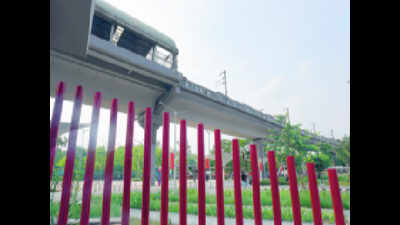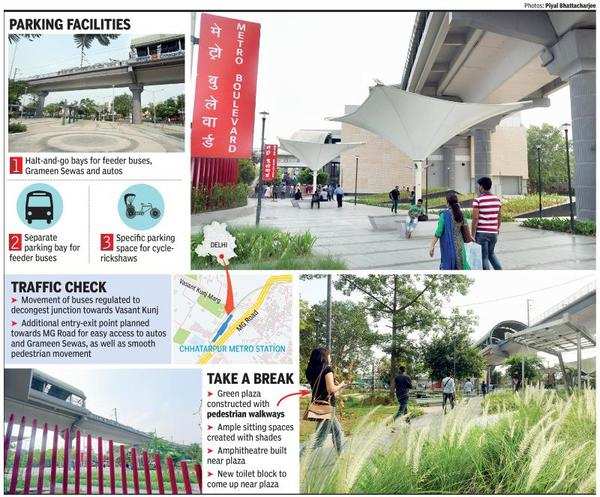- News
- City News
- delhi News
- Delhi: Chhatarpur metro station becomes island of tranquillity after first-of-its-kind makeover
Trending
This story is from July 7, 2019
Delhi: Chhatarpur metro station becomes island of tranquillity after first-of-its-kind makeover
Located at a major traffic intersection where two busy roads merge, the Chhatarpur metro station has emerged as an island of tranquillity. Lush greenery and shaded sitting areas now welcome commuters to a public plaza just below the station.

Chhatarpur metro station
NEW DELHI: Located at a major traffic intersection where two busy roads merge, the Chhatarpur metro station has emerged as an island of tranquillity. Lush greenery and shaded sitting areas now welcome commuters to a public plaza just below the station.

The station, where Delhi Metro Rail Corporation (DMRC) undertook the makeover in the last few months, is the first where a project of its kind was attempted.The train company has not only provided a public plaza, but also created halt-and-go parking bays for buses, Grameen Sewa vehicles and autorickshaws, altogether promising smoother traffic flow around the station. Work on the redevelopment project began last year and is now finished. Though the public plaza has been thrown open, the parking bays and multi-modal integration zone are yet to be opened to vehicles because DMRC plans an official inauguration.
A DMRC official said that a vacant expanse between the compound wall and slip road had not been fully used. This unutilised space has been developed into a green plaza with pedestrians walkways. The plaza also has an amphitheatre, landscaping with green grass and plants, sit-out places and tensile steel structures. A new toilet block is to be added there, the official said.
The use of the road beneath the Yellow Line (HUDA City Centre-Samaypur Badli) viaduct by private vehicles to access the metro parking created traffic jams. The bus stops on the roads on both side of the metro station and haphazard parking and halting by buses lead to congestion. DMRC now has designated parking areas for para transit modes like autorickshaws and Grameen Sewa vehicles, which will be opened soon. “We are stopping the
The movement of pedestrians around the station also used to be random and chaotic, but it now promises to be organised with DMRC creating a network of pathways flanked by greenery to facilitate smooth pedestrian movement. Halt-and-go bays have been created for the para transit vehicles and metro feeder buses while the cycle rickshaws too have been provided space for operation. DMRC has also regulated the movement of buses so that the junction towards Vasant Kunj remains freer than it is now. The company is also planning another entry/ exit towards Mehrauli-Gurgaon Road to allow easier access to vehicles without hampering the smooth movement of pedestrians.
The Chhatarpur metro station is unique because it is the only station in the entire Delhi Metro network that has been constructed fully of steel. The reason why such a decision was taken was the shortened time available for the station’s construction because DMRC had to finish the completion of the line before the start of the Commonwealth Games held in Delhi in October 2010.
The land on which the station was to come up was under litigation and the metro corporation couldn’t start construction on the scheduled time. By the time it acquired the land, there was no time to build a station of concrete and steel like the conventional metro station. As a result, the station was built completely of steel in a record time of just eight months.
In the last nine years, however, the area around the Chhatarpur metro station had turned into an island of chaos due to the unregulated movement of different modes of transport. The redevelopment project including the public plaza and implementation of MMI was to correct the problems that were created by the hurried pace at which the station was built.

The station, where Delhi Metro Rail Corporation (DMRC) undertook the makeover in the last few months, is the first where a project of its kind was attempted.The train company has not only provided a public plaza, but also created halt-and-go parking bays for buses, Grameen Sewa vehicles and autorickshaws, altogether promising smoother traffic flow around the station. Work on the redevelopment project began last year and is now finished. Though the public plaza has been thrown open, the parking bays and multi-modal integration zone are yet to be opened to vehicles because DMRC plans an official inauguration.
A DMRC official said that a vacant expanse between the compound wall and slip road had not been fully used. This unutilised space has been developed into a green plaza with pedestrians walkways. The plaza also has an amphitheatre, landscaping with green grass and plants, sit-out places and tensile steel structures. A new toilet block is to be added there, the official said.
Being the meeting point of roads going towards Gurgaon, Vasant Kunj and Chhatarpur, the area sees heavy traffic movement, particularly at peak hours. The different modes of transport used for last-mile connectivity by Delhi Metro users, among them buses, autos, rickshaws, private cars and Grameen Sewa vans, has made the intersection a choke point.
The use of the road beneath the Yellow Line (HUDA City Centre-Samaypur Badli) viaduct by private vehicles to access the metro parking created traffic jams. The bus stops on the roads on both side of the metro station and haphazard parking and halting by buses lead to congestion. DMRC now has designated parking areas for para transit modes like autorickshaws and Grameen Sewa vehicles, which will be opened soon. “We are stopping the
auto drivers and Grameen Sewa drivers from parking in the new zone until the inauguration,” revealed a guard deployed at the MMI zone.
The movement of pedestrians around the station also used to be random and chaotic, but it now promises to be organised with DMRC creating a network of pathways flanked by greenery to facilitate smooth pedestrian movement. Halt-and-go bays have been created for the para transit vehicles and metro feeder buses while the cycle rickshaws too have been provided space for operation. DMRC has also regulated the movement of buses so that the junction towards Vasant Kunj remains freer than it is now. The company is also planning another entry/ exit towards Mehrauli-Gurgaon Road to allow easier access to vehicles without hampering the smooth movement of pedestrians.
The Chhatarpur metro station is unique because it is the only station in the entire Delhi Metro network that has been constructed fully of steel. The reason why such a decision was taken was the shortened time available for the station’s construction because DMRC had to finish the completion of the line before the start of the Commonwealth Games held in Delhi in October 2010.
The land on which the station was to come up was under litigation and the metro corporation couldn’t start construction on the scheduled time. By the time it acquired the land, there was no time to build a station of concrete and steel like the conventional metro station. As a result, the station was built completely of steel in a record time of just eight months.
In the last nine years, however, the area around the Chhatarpur metro station had turned into an island of chaos due to the unregulated movement of different modes of transport. The redevelopment project including the public plaza and implementation of MMI was to correct the problems that were created by the hurried pace at which the station was built.
End of Article
FOLLOW US ON SOCIAL MEDIA










